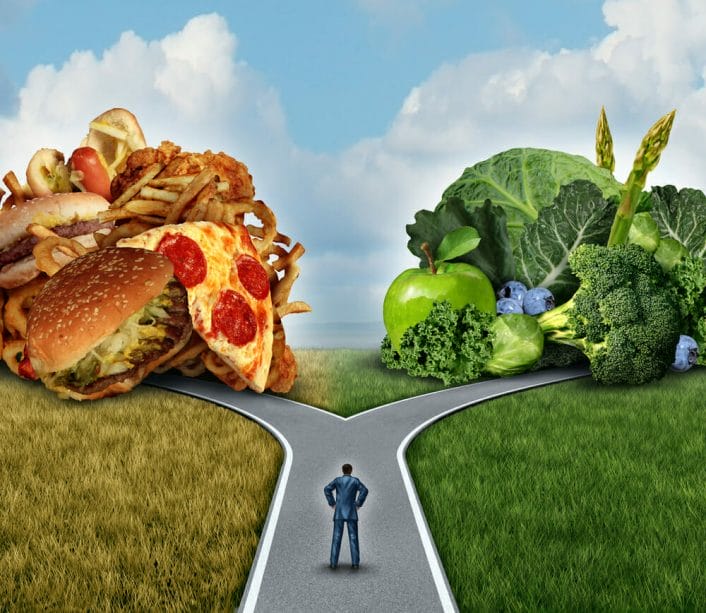Insulin resistance is an increasingly common metabolic disorder associated with poorly functioning carbohydrate metabolism in the body. It usually affects young and middle-aged people who are overweight and have problems with weight reduction. Insulin resistance results in decreased sensitivity of tissues and cells to insulin, the hormone responsible for maintaining normal blood sugar levels.
Insulin resistance is usually the result of a poor diet, dominated by carbohydrates with a high glycemic index. What’s important, untreated insulin resistance is a very dangerous condition, because it inevitably leads to the development of type 2 diabetes, what’s more, it can also affect the occurrence of other diseases. What are the symptoms of insulin resistance? How to diagnose insulin resistance and how to fight it effectively?
Table of contents
- 1 What is insulin resistance and how does it develop?
- 2 What are the consequences of insulin resistance? What diseases can insulin resistance lead to?
- 3 Insulin resistance – symptoms
- 4 Insulin resistance – causes, risk factors
- 5 Insulin resistance – diagnosis, tests
- 6 Insulin resistance – treatment
- 7 Insulin resistance – diet. What to eat and what to avoid in case of insulin resistance?
- 8 Physical activity is an important factor in the fight against insulin resistance
What is insulin resistance and how does it develop?
We hear more and more about insulin resistance as a pressing health problem resulting from an unhealthy lifestyle. In fact, insulin resistance is generally closely associated with poor diet and a sedentary lifestyle. Very often, in fact almost always, it is accompanied by an inability to maintain a normal body weight and excess body fat, especially in the abdominal area.
What is insulin resistance? To answer this question it’s worth to understand the mechanism of insulin action and its influence on blood glucose level. Insulin is a hormone secreted by the pancreas, responsible for stabilizing blood sugar levels and supplying cells and tissues with energy material in the form of glucose. In addition, insulin is also involved in the metabolic processes of proteins and fats.
After a meal, carbohydrates are broken down and then absorbed from the digestive tract into the bloodstream. As a result, the concentration of glucose in the blood rises. Then insulin is released, with the help of which glucose is transported from the blood into the cells throughout the body. As a result, the blood sugar level is stabilized.
Rational, balanced diet ensures balance in insulin-glucose metabolism and lack of sugar level disturbances. The problem starts to exist when there are too many carbohydrates with a high glycemic index in our daily diet.
These are very quickly broken down and released from the gastrointestinal tract into the blood. The direct result is an increase in blood glucose to an unnatural level.

The reaction to this phenomenon is an intense release of insulin, whose task is to normalize the sugar level as quickly as possible. Some of the glucose goes into the body’s tissues, but any excess is pushed into the spare energy material, i.e. fat tissue.
Insulin resistance occurs when, as a result of continuous rapid spikes in blood sugar, larger and larger amounts of insulin are released. Eventually the cells of our body stop responding to it properly, they become more and more resistant to insulin (hence the name insulin resistance). The cells do not receive the proper amount of fuel needed to function properly, blood sugar levels do not drop, so the body successively increases and increases insulin secretion.
The loss of sensitivity of cells to insulin results in an increasing overproduction of this hormone (hyperinsulinemia), but the blood glucose level is not reduced to normal. Abnormalities in carbohydrate metabolism increase, with time, the regulatory mechanisms in the body become exhausted.
First, insulin resistance develops, which then turns into a pre-diabetic state, and then into type 2 diabetes.
What are the consequences of insulin resistance? What diseases can insulin resistance lead to?
First of all, insulin resistance increases the risk of developing type 2 diabetes, but also other conditions, including cardiovascular diseasescardiovascular diseases, such as hypertension, ischemic heart disease, atherosclerosis, and non-alcoholic fatty liver.
Insulin resistance can also lead to weakening of the pancreas and impairment of its function. Insulin resistance is almost always associated with overweight and obesity (successive growth of both external adipose tissueexternal adipose tissue and dangerous visceral fat located around the internal organs).
The consequences of insulin resistance may also include various metabolic and hormonal disorders, infertility, polycystic ovary syndrome, gout, sleep apnea. As you can see from the possible consequences, insulin resistance is a dangerous condition that we should not underestimate in any case.
Insulin resistance – symptoms
Insulin resistance leads to a decrease in glucose uptake by cells and tissues, including skeletal muscles, liver cells or fat tissue. The metabolism of carbohydrates, fats and proteins is disturbed and glucose is not optimally utilized by the cells of our body.
Decreased sensitivity of cells to insulin results in hyperglycemia (excess of glucose in the blood). Lipid metabolism is also disregulated. Not only does an excess of sugar, but also of fatty acids circulate in our blood, which leads to increased accumulation of fat tissue and continuous weight gain.
Sometimes insulin resistance is asymptomatic, but usually it can be diagnosed on the basis of certain symptoms.
The most common symptoms of insulin resistance
- increase of fat tissue, rapid and easy weight gain, especially in the abdominal area (with time our figure takes the shape of an apple),
- problems with reducing body weight despite physical activity and diet,
- excessive appetite, attacks of ravenous hunger,
- increased craving for sweets,
- frequent headaches,
- frequent fatigue, lack of energy,
- mood swings,
- depressive disorders,
- daytime sleepiness (especially after meals),
- problems with concentration,
- excessively high blood pressure,
- hyperhidrosis,
- elevated sugar, cholesterol and triglycerides,
- skin problems (dark keratosis),
- increased concentration of uric acid in the body.
Insulin resistance – causes, risk factors
What factors increase the risk of developing insulin resistance? Here are the most important ones:
- overweight and obesity due to too much sugar and fat in the diet,
- dietary mistakes (e.g. These include: overweight and obesity caused by too much sugar and fat in the menu, dietary mistakes (e.g. skipping breakfast, irregular meals, too few and too many meals, too many carbohydrates with a high glycemic index in the menu, too many saturated and trans fats in the menu),
- sedentary lifestyle, too little physical activity,
- chronic stress,
- chronic sleep deprivation,
- genetic background,
- certain diseases (e.g. Hashimoto disease),
- taking certain medications (e.g. steroids, antibiotics, hormonal contraception).
The risk of insulin resistance is also higher in people struggling with endocrine diseases and in women who have undergone gestational diabetes during pregnancy.
Insulin resistance – diagnosis, tests
If we suspect we have insulin resistance, we can check our sugar levels ourselves with a simple glucometer, but we can also conduct special laboratory tests that will allow us to definitively ascertain whether or not we have insulin resistance.
The basic test used to diagnose insulin resistance is the so-called oral glucose load test (OGTT), or oral glucose tolerance test, or sugar curve. The test determines the fasting glucose level and the glucose level after taking a solution of water and glucose.
Other tests that are performed to diagnose insulin resistance are:
- insulin tolerance text,
- fasting glucose,
- fasting insulin levels,
- HOMA-IR index,
- glycated hemoglobin,
- lipid profile,
- metabolic clamp method.
Insulin resistance – treatment
On the basis of the test results, the doctor decides whether the patient needs pharmacological treatment or it is enough to change the lifestyle in order to reduceThe doctor determines whether the patient needs pharmacological treatment or lifestyle changes are enough to lower insulin and glucose levels, increase cell sensitivity to insulin and finally normalize glycemia.
Therefore, the most important element of the treatment of insulin resistance is the diet, in which, first, we limit the number of calories consumed daily, second, we give up products with a high glycemic index, and we use products with an average glycemic index and a low glycemic index. This diet will help us reduce body weight and stabilize glucose-insulin balance.
Insulin resistance – diet. What to eat and what to avoid in case of insulin resistance?

The diet for insulin resistance (insulin diet) is designed to prevent rapid spikes in blood sugar, and thus normalize insulin secretion and stabilize the entire carbohydrate balance in the body. Therefore, in the diet with insulin resistance, special attention should be paid to the amount and type of carbohydrates.
The most harmful, responsible for insulin-glucose metabolism disorders, are carbohydrates with a high glycemic index and high glycemic load, i.e. white flour products, sweets, processed foods. These are digested very quickly and cause a rapid and strong increase in blood sugar levels, so they should definitely be avoided.
Instead, carbohydrate products with a low glycemic index and a high content of dietary fiber (they are digested slowly and do not result in sudden spikes in blood glucose) are recommended for us. In moderation, we can reach for products with an average glycemic index.
Remember that products with a high fat content are also bad for us. Avoid fried dishes, fast food, fatty meats and fatty batches of meat, products with trans fats. As a method of processing food, instead of frying, choose boiling, steaming, baking without fat, stewing.
Products recommended in the diet with insulin resistance
- vegetables,
- legumes,
- grains,
- nuts,
- whole grain products (e.g. wholemeal bread, wholemeal pasta, brown rice),
- buckwheat groats,
- oat groats,
- bulgur groats,
- spelt groats,
- pearl barley groats,
- quinoa,
- fruits (especially those with lower sugar content and less ripe),
- cereals,
- bran,
- lean meats, fish,
- lean, good quality cold cuts,
- dairy products,
- eggs,
- olive oil and good quality vegetable oils.
When preparing meals, try not to overcook the food (the longer the cooking, the higher the glycemic index of the dish). Consume 5 meals a day every 3-4 hours. Eat nutritious breakfasts, do not snack between meals.
Products prohibited in the diet with insulin resistance
- white bread,
- pastries, cakes, challahs, doughnuts, sweet buns, buttered buns,
- toasted bread,
- white flour products (e.g. white pasta, noodles, dumplings),
- ready-made sweetened muesli mixes,
- sweets,
- ice cream,
- jams,
- sugar,
- honey,
- chips, sticks and other salty snacks,
- instant foods (e.g. instant soups),
- frozen ready meals,
- fast food,
- ready-made sauces,
- small groats,
- white rice,
- very ripe bananas,
- candied fruits,
- French fries, baked potatoes,
- mashed potatoes,
- fatty meats and sausages,
- heavy, floury sauces,
- sweetened cheese and dairy desserts, yogurt with added sugar.
The type of liquids we consume is also very important for insulin resistance. We should avoid sweetened drinks, fruit syrups, energy drinks and alcohol. We should also be careful with bought fruit juices, because they often contain sugar or glucose-fructose syrup.
Drink mainly mineral water (about 1.5 l – 2 l a day).
In addition to water in insulin resistance we can reach for such drinks as:
- green tea, white tea,
- black tea without sugar,
- coffee without sugar,
- freshly squeezed juices of low GI fruit and vegetables,
- smoothies from a blender (with a predominance of vegetables, with the addition of whole grain cereals with a high fibre content such as flaxseed, bran, chia seeds).
Read also: Diabetic diet
Physical activity is an important factor in the fight against insulin resistance
In the case of insulin resistance, in addition to the introduction of a healthy diet without carbohydrates with a high glycemic index, it is also very important to break the sedentary lifestyle. Lack of exercise promotes the growth of diabetic problems, and conversely, regular exercise contributes to increasing the sensitivity of cells to insulin and normalizing sugar levels.
This is because the muscles, which are stimulated to work, have an increased need for energy, they “need” fuel in the form of glucose.They become less resistant to the hormone which supplies them with glucose, that is insulin. It is therefore worth betting on regular physical activity, of course in any form, according to our preferences (e.g. running, gym, swimming pool, dynamic walks, team games, cycling etc.).
If we want to get rid of insulin resistance quickly and efficiently, it’s worth to follow not only physical activity and diet, but also the following guidelines
- avoid stress,
- take care of a sufficiently long and good sleep,
- Use herbs and spices which have a beneficial effect on the insulin-glucose balance in the body (e.g. ginger, curcuma, white mulberry, curry, cinnamon)
- use dietary supplements that regulate sugar levels and reduce insulin resistance (e.g. the innovative Redusugar formula).
In the fight for normalization of insulin secretion it is also important to avoid diabetogenic drugs.
Go to the review of the product regulating sugar levels and fighting insulin resistance Redusugar

Sources:
- https://www.medicalnewstoday.com/articles/305567
- https://www.healthline.com/health/diabetes/insulin-resistance-symptoms
- https://www.healthline.com/nutrition/insulin-and-insulin-resistance

